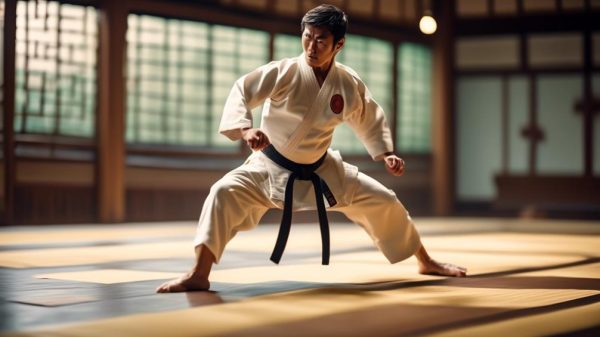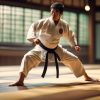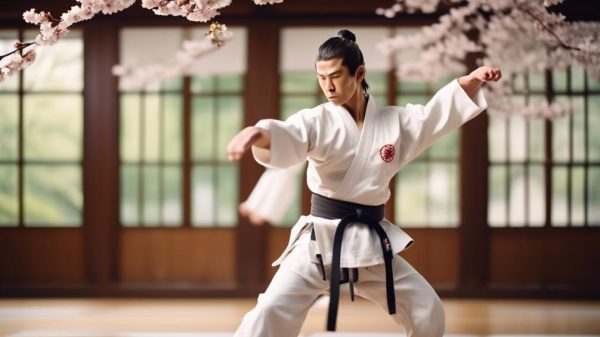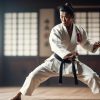Goju Ryu is a traditional style of karate from Okinawa, Japan. Practicing kata forms teaches Goju Ryu students self-defense applications.
These karate dances have names reflecting key philosophies for martial artists. Understanding meanings adds depth when training each kata.
For example, “Saifa” represents destructive power while “Seiyunchin” symbolizes overwhelming force and vitality. Interpreting other katas guides mental focus too.
Beyond conditioning the body, forms like these ingrain cultural wisdom into Goju Ryu practitioners. Insight comes through contemplating the essence behind motions.
Exploring Goju-Ryu Kata
Goju-Ryu is a kind of karate that uses both hard and soft techniques. A kata is a set pattern of movements that karate students practice to improve their skills.
Goju-Ryu has twelve main kata that students learn as they progress through different colored belt levels.
The first few kata introduce basic stances, blocks, and strikes. More advanced kata add more complex motions like jumps, spins, and combinations of techniques.
Practicing kata helps karateka develop better form, balance, speed, and breathing control.
Through repetition, the movements become natural so they can be used in actual self-defense situations. Learning all the kata takes dedication over many years of karate training.
Historical Significance of Goju-Ryu
Goju-Ryu is a style of karate that historical because it is one of the first mixes of soft and hard techniques. It was created in the 1900s by Chojun Miyagi in Okinawa who studied Chinese martial arts.
Miyagi combined hard striking from other Okinawan styles with soft circular blocking and breathing from kung fu to make a balanced form called Goju-Ryu, meaning “hard-soft style.” This mix was new and more realistic for self-defense fight situations.
Goju-Ryu became very popular and spread as students taught it to others around the world. Today it remains an influential karate discipline. Major techniques added by Goju-Ryu like tension breathing during kata and vertical fist punches have lasting impacts. By successfully blending hard and soft methods, Goju-Ryu has historical significance in shaping modern mixed martial arts.
Origin and Evolution
Origin and Evolution of Goju-Ryu Karate
The roots of Goju-Ryu Karate can be traced back to the 1920s when Miyagi Chojun Sensei laid the foundation for what’s now become a globally recognized martial art with significant historical importance. The development of Goju-Ryu has been characterized by a balance between traditional practices and the incorporation of diverse interpretations across various schools.
Key Milestones in Goju-Ryu Karate
- 1920s: Founding by Miyagi Chojun Sensei
- This laid the groundwork for the core principles and katas of Goju-Ryu Karate.
- 1933: Formal naming and registration
- This led to increased formal recognition and the expansion of Goju-Ryu Karate.
- 1930s: Shinzato Sensei’s tournament performance
- Elevated public awareness and interest in Goju-Ryu Karate.
- Contemporary: International Federation’s governance
- This ensures global standardization and the spread of Goju-Ryu Karate worldwide.
As practitioners master the katas and delve into the origins and evolution of Goju-Ryu, they’ll come to appreciate the dynamic interplay of soft and hard techniques that define this school of Karate.
Cultural Impact
Cultural Impact
Goju-Ryu’s transformative journey under Miyagi Chojun Sensei has had a significant historical influence, extending well beyond the dojo to shape cultural paradigms in the martial arts community and beyond. Here’s how:
- Pioneering Influence: Goju-Ryu’s innovative combination of hard and soft techniques has had a revolutionary impact on martial arts, inspiring the development of other styles.
- Cultural Integration: The global proliferation of Goju-Ryu, particularly through the International Okinawan Goju-Ryu Karate-Do Federation, has deeply embedded its principles into the fabric of martial arts culture.
- Historical Legacy: Miyagi Sensei’s contributions ensure that Karate katas carry a legacy that informs martial arts integrity and historical understanding.
- Cultural Impact: The Kata of Goju-Ryu serve as a cultural touchstone, reflecting the art’s profound influence on the martial arts world and its commitment to preserving the integrity of the form.
Kata Technique Breakdown
Mastering the Kata Technique Breakdown is integral to understanding Goju-Ryu. This technique unravels the purpose behind every stance, strike, and block, emphasizing the importance of precise movement analysis.
It ensures that stances and postures aren’t only correct but also imbued with strength and fluidity, breathing life into the kata.
Rhythm and breathing patterns act as invisible guides, harmonizing power and grace in each executed technique.
Kata Movement Analysis
Exploring the intricacies of Goju-Ryu kata involves a detailed analysis of each movement, unveiling the depth and practicality inherent in this traditional martial art form.
As you engage in training, understanding the nuances of kata movement becomes essential, enabling you to grasp the subtleties and real-world applications of your katas.
Here’s what to focus on:
- Scrutinize each step to ensure precise biomechanics and balance.
- Uncover the purpose behind every block, strike, and stance.
- Pay attention to any subtle variations that your instructors may incorporate.
- Practice seamless transitions between movements to cultivate fluidity and power.
Mastering these elements is crucial. Your instructors will skillfully guide you through the intricacies of each technique, ensuring that your execution isn’t only technically accurate but also effective for self-defense.
Embrace their corrections and insights as they’ll significantly enhance your practice.
Stance and Posture Essentials
Understanding the significance of your stance in Goju-Ryu kata is crucial. It acts as the cornerstone that directly influences the impact of your punches, blocks, and kicks.
The essentials of stance and posture in Goju-Ryu go beyond mere physical alignment; they embody the very essence of the Karate katas.
As you dive into the official 12 katas, each stance you assume symbolizes your discipline and concentration.
| Emotion | Stance | Impact |
|---|---|---|
| Resolve | Sanchin | Power |
| Agility | Neko Ashi Dachi | Precision |
| Stability | Shiko Dachi | Endurance |
Mastering the fundamental katas in Goju-Ryu means internalizing these principles with unwavering dedication. Stand resolute, move with purpose, and let your stances convey profound meaning.
Breathing and Rhythm Patterns
Harnessing the power of your Goju-Ryu kata hinges on mastering the intricate dance of breath and rhythm that fuels each movement.
To excel, you must understand that each kata is occasionally separated into segments, each with its breathing and rhythm patterns.
Here are the steps required:
- Learn Proper Breathing Techniques: Instructors will guide you through the process of synchronizing your breath with your movements to maximize power.
- Understand the Rhythm Patterns: Each kata has a unique rhythm that dictates the pace and flow of the techniques.
- Practice Consistently: Regular training ingrains these patterns into muscle memory, allowing for seamless execution.
- Refine with Expert Feedback: Seek continual guidance from instructors for the steps, ensuring precision and effectiveness in your practice.
Philosophical Interpretations
Goju-Ryu focuses on balance between hard and soft. This reflects the Chinese concept of yin and yang – opposing forces that complement each other.
Goju philosophical views see these dualities in many aspects of karate technique and application.
For example, linear hard movements match with circular soft movements. Fast, intense attacks balance with slow, relaxed breathing.
And self-defense aims combine harming an opponent with protecting oneself or others.
Through Goju training, students develop physically and mentally at the same time. Lessons apply not just to fighting, but goals in school, hobbies, and relationships.
This balance and unity allows a flexibility to shift between styles when needed to overcome challenges. It relates to core Eastern ideas about harmony with contrasts – expressed through the mix of Goju-Ryu martial arts.
Practical Applications
Practical Applications
In understanding Goju-Ryu kata, the practical applications are essential for embodying these teachings in real-life self-defense situations.
The katas go beyond ceremonial significance; each movement serves a purpose, aiming to prepare individuals for the unpredictable nature of physical confrontations.
To excel in the practical applications of Goju-Ryu, consider the following:
- Study Kata Demonstrations: Utilize resources such as AllTheMartialArts.com or YouTube to analyze detailed kata demonstrations. Observe how experts translate fluid movements into practical defense techniques.
- Precise Practice: Each technique within the Karate katas demands exact execution. Pay close attention to stances, hand positions, and transitions for effective application.
- Understand the Context of Combat: Goju-Ryu katas encapsulate self-defense strategies. Seek to understand the combat implications behind each movement, whether it involves a block, strike, or evasion.
- Guidance from Instructors: Regular feedback from instructors is vital. They provide the nuanced insights necessary to refine your technique from mere practice to real-world readiness.
Training Insights and Tips
To enhance your Goju-Ryu training, it’s important to incorporate valuable insights and personalized tips to improve your practice in this martial art form.
Explore the deeper meanings behind Goju-Ryu Katas to grasp the intricacies that render them effective. Below are specific areas to focus on:
| Training Focus | Tips |
|---|---|
| Kata Precision | Understand the purpose behind each movement and seek guidance from your instructors to harness the power in your techniques. |
| Strength & Flexibility | Integrate Hojo Undo and regular stretching into your routine to enhance your physical abilities for Karate katas. |
| Adaptation | Acknowledge the existence of slight variations in techniques across different schools and remain open to how organizations borrow and adapt these techniques. |
Incorporate these insights as you refine your skills. Remember, mastery isn’t just about repetition; it’s about understanding the ‘why’ behind every punch, kick, and block.
Your journey is unique but is built on the shared wisdom of generations. Keep pushing, keep learning, and let the legacy of Goju-Ryu Karate fuel your dedication to excellence.
Frequently Asked Questions
What Are the 12 Katas of Goju-Ryu?
As you progress through belt levels, you will learn and master 12 unique Goju-Ryu katas, each with its own origins and variations. This training will sharpen your skills and breathing techniques, essential for advancing to higher levels of mastery.
What Is the Meaning of Kata in Goju-Ryu Karate?
In Goju-Ryu karate, kata holds deep significance as it embodies the rich tradition of the martial art. It imparts essential breathing control techniques and imparts self-defense strategies.
Through kata, practitioners learn to seamlessly transition between stances, decipher bunkai applications, and follow embusen lines, thereby mastering the foundational principles and historical depth of this ancient art form.
How Many Katas Are There in Goju-Ryu?
In Goju-Ryu, there are 12 core katas, each providing distinct training benefits. These include stance transitions, breathing techniques, and application variations rooted in kata origins that help in achieving mastery levels.
What Does the Goju-Ryu Symbol Mean?
The Goju-Ryu symbol represents martial balance, harmony, and Okinawan roots. It embodies the concept of Yin Yang, symbolizing the philosophy it represents.









